As winter settles in and the temperatures begin to hit seasonal lows, we are reminded of the power our homes have to protect us from the chill. Some are grateful for the fortitude of their home and thankful to remain warm and cozy as the snowflakes fall outside. But others may fight with their thermostats, pile on sweatshirt after sweatshirt, and shiver from room to room as a noticeable draft sweeps through the house. ‘Tis the season to have home insulation on the mind! And so, this week, we will discuss one of the most commonly asked questions we receive about insulation: how do I know if I need it?
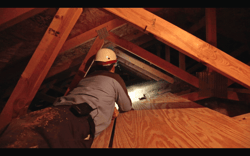
What is home insulation?
Before learning the telltale signs of needing proper attic insulation, it’s important to understand what insulation is. According to Energy.gov, insulation is generally defined as any type of material that provides a barrier between a home’s walls, ceilings, or floors and serves to control temperature and noise. Homes may contain various insulation materials, all offering their own set of benefits and drawbacks. Three of the more common types of insulation materials include foam, fiberglass, and cellulose.
Foam insulation offers material in two forms: spray foam or injection foam. Spray foam is sprayed directly into open cavities in a home, often in new construction homes, crawl spaces, attics, etc. Spray foam is liquid when applied and expands to fill the cavity it was sprayed into. Injection foam, however, is pumped into existing cavities like in an older home’s walls and fills the empty space. Injection foam does not expand or lose shape.
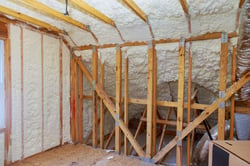 Foam Insulation
Foam Insulation
Fiberglass insulation comes in fluffy bats and rolls made of plastic reinforced by tiny glass fibers. One of the more prevalent and recognizable insulations, fiberglass insulation, can be used in a multitude of areas within a home, including walls, floors, ceilings, and even ducts. This material is generally considered to be a cost-effective insulation solution.
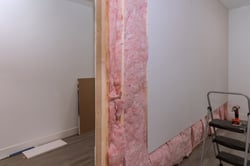 Fiberglass Insulation
Fiberglass Insulation
Cellulose insulation is a fiber insulation used predominantly in existing walls, open new walls, and unfinished attic floors. This material is a loose fibrous insulation made up of up to 85% recycled paper or wood products. Because of its loose shape, cellulose insulation can be used to insulate a variety of areas within a home that may be otherwise difficult to insulate with other materials.
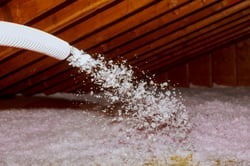 Cellulose Insulation
Cellulose Insulation
Most insulations can last decades in a properly maintained home; however, outside factors may degrade insulation over time and make it less effective.
what are the benefits of cellulose insulation?
- Comfort - Of course, the most obvious benefit to a well-insulated home is protection from escaping heated or cooled air. A properly insulated home will stay warmer during the winter and cooler in the summer due to its ability to keep inside air in and outside air out. Homes with quality and sufficient insulation will be comfortable to live in year-round as they remain more temperature-controlled than a drafty house.
- Noise reduction - Another benefit of a well-insulated home is noise reduction. Insulation provides a barrier to noise both inside and outside the home - meaning you hear less of what’s going on outside, and outside hears less of what’s going on inside. Insulation’s noise dampening effects are especially noticeable to those who live near busy roads, in bustling cities, or even in densely packed neighborhoods where homes are situated very close together. Ask anyone with a sleeping baby and a neighbor mowing their lawn - insulation’s ability to reduce noise is important!
- Lower energy costs - Homeowners with homes that are properly insulated can expect lower energy costs, as well. Houses that have failing insulation, not enough insulation, or air leaks may have energy bills up to 15% higher than a well-insulated home. Poor insulation can also cause additional wear and tear on a home’s heating and cooling units, causing premature system failure.
- Resale value - According to the US Green Building Council, homes with upgraded insulation sell for an average of 8% more than less efficient homes. It’s also been shown that energy-efficient upgrades (such as insulation) are some of the best home improvements you can make for your home’s resale value. As of 2022, homes that are labeled as “energy-efficient” receive preference for new homebuyers.
- Keep pests out - A lesser-known benefit to quality home insulation is its use as a pest prevention measure. Spray foam can be an excellent line of defense against pests due to its ability to expand and fill even the smallest of cracks and spaces, preventing insects from making entry. Densely packed cellulose insulation can be another successful hindrance to pests as it is difficult for pests to push through and allows for very little airflow. Common entry points for pests, such as the attic, crawl space, or basement, are also common areas where insulation can be applied. For additional protection, EcoShield offers a unique pest-treated cellulose insulation to keep your home protected from both pests and the elements.
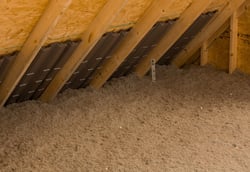 Densely packed cellulose insulation
Densely packed cellulose insulation
What are some signs that my home needs insulation?
Homes with insufficient or degraded insulation will “tell” you in a variety of ways that it’s time to upgrade. If you’re concerned your home may need insulation, look out for these telltale signs:
- Frequent and inconsistent fluctuations in temperature. Homes with quality insulation will maintain a consistent, comfortable temperature from room to room. When a home’s insulation is inadequate, homeowners will experience severe temperature fluctuations that vary among rooms and levels of the home.
- Your walls and ceilings are cold to the touch. Chilly walls or ceilings can be indicative of a lack of insulation in those areas or that existing insulation is beginning to fail.
- Energy and heating bills are high. One of the biggest signs that your home needs quality insulation is a rise in energy and heating bills. Continually heating a drafty house takes a lot of energy and heating fuel; this not only causes unnecessary wear to your heating and cooling units but also results in paying more out of pocket to keep your home comfortable.
- Noticeable drafts, breezes, or concentrated chills. If you’re experiencing drafts when all your home’s windows and doors are shut, poor insulation is more than likely the culprit.
- Freezing gutters and ice dams. Homes with inadequate insulation will leak precious warmed air through the roof, melting snowfall and sending runoff into your gutters. Water can then freeze, blocking up your gutters and even resulting in dangerous icicle formations along the gutter’s edge.
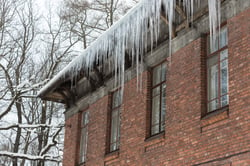 Icicle formations due to frozen gutters
Icicle formations due to frozen gutters
WHAT SHOULD I DO IF MY HOME’S INSULATION IS INSUFFICIENT OR NEEDS REPAIR?
It’s important that you contact a trusted professional for any kind of home insulation needs. We advise against DIY insulation work as certain kinds of materials used may pose health hazards if proper safety measures aren’t taken. EcoShield’s insulation experts are trained in the necessary safety protocols to ensure the safety of you and your family. Whether you're replacing old insulation, adding extra insulation to your existing home, or insulating a brand new home, consider pest control Insulation Shield from EcoShield. Call us today or fill out the form on this page to schedule a no obligation estimate!